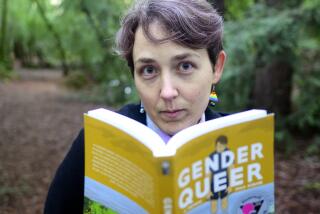A love without end
- Share via
When the Modernist magi T.S. Eliot and Ezra Pound laid down the canons of literary taste that still hold sway today, largely intact despite decades of siege by critics with political agendas, Dante was placed on a pinnacle above all other poets of the post-Classical age. Yet for centuries before, Dante’s fellow Tuscan and near-contemporary Francesco Petrarca, known as Petrarch, was just as celebrated, and his love poems addressed to the lady Laura were as widely read as the “Divine Comedy” and probably even more influential.
Petrarch, who lived from 1304 to 1374, may well be the most widely imitated poet in the Western tradition. His collection of poetry in vernacular Italian, popularly known as the “Canzoniere,” or songbook, established the formal and conceptual idiom that dominated love poetry from the Renaissance to modern times. He took the classical notion of idealizing and worshipping the beloved and, inspired by the Provencal troubadours, infused it with Christian mysticism. To express this perfect love, Petrarch refined what would become the most popular verse form of Western literature, the sonnet. Before Petrarch, it was just one of many genres available to lyric poets, but after he demonstrated the sonnet’s expressive range in 317 of the songbook’s 366 canzoni, the compact, musical 14-line form gained decisive dominance in European poetry.
In the 20th century, Petrarch lapsed into obscurity. Today, knowledge of his poetry is mostly confined to scholars specializing in medieval literature -- in part because of the Modernists’ veneration of Dante, at his expense, and partly because of Petrarch’s extravagant figures of speech, which sounded extreme long before the cool sensibility of the 20th century. Even by the Elizabethan Age, Petrarch’s penchant for paradox seemed quaint: Sir Philip Sidney had Petrarch in mind when he lampooned poets who, in their descriptions of love, speak “Of force of heav’nly beams infusing hellish pain; / Of living deaths, dear wounds, fair storms, and freezing fires.” Sidney, Shakespeare and the other early English sonneteers imbibed Petrarch’s example and then transformed and even rebelled against it, making the aesthetic of the original seem prematurely old-fashioned.
Another reason for the decline of Petrarch’s reputation in the English-speaking world has been the lack of a good modern translation: Most of the versions of the songbook that have been available since the Victorian period have been second-rate poetry, flowery and artificial in tone. Yet even when Petrarch’s ideas are complex and ornate, his language is direct. The “Canzoniere” has long awaited a translator to reveal the clarity and grace of the original to contemporary readers, as John Ciardi did for the “Divine Comedy” half a century ago.
Petrarch has found his Ciardi in the American poet David Young, who has produced a supple English version of the complete songbook in blank verse, which is at once faithful and elegant. The perennial problem in translating Italian poetry is that although Italian abounds with rhyme, English is relatively impoverished in this respect. The Petrarchan sonnet is particularly demanding and almost impossible to reproduce in English without falling back on strained rhymes and awkward word order.
Young’s decision to render Petrarch’s lyrics in blank verse is amply justified by the results, which preserve the dignity of the original while maintaining a musical, “poetic” effect. Perhaps the greatest compliment to be paid Young’s translation is that although it never strays from the literal sense of the original, written more than 600 years ago, the language always sounds fresh and contemporary. The book is beautifully produced, with the bare essential of annotation provided in marginal glosses rather than in the usual clutter of footnotes.
Setting a precedent followed by the best of the poets who imitated him, from Shakespeare to Rilke, Petrarch created a loose psychological narrative in his sonnet cycle: Boy meets girl, boy doesn’t get girl, boy thinks about girl for the rest of his life. When he was just 22, a dandy and a scholar at the exiled papal court in Avignon, Petrarch first saw Laura at a church service on Good Friday and fell in love with her on the spot. No poet ever expressed the visceral power of new love more effectively as here:
the way that thunder comes along with lightning
that’s how those eyes, so brilliant, hit me,
along with a sweet greeting from her lips.
True to the conventions of courtly love, Petrarch never consummated his passion. Laura married soon after that first meeting with Petrarch; scholars identify her husband as an ancestor of the Marquis de Sade, who wrote about the torments of love in a distinctly carnal mode. Laura died a few years later, a victim of the Black Death, but Petrarch, and his love, lived on for a quarter of a century.
As Young suggests in his excellent introduction, Petrarch’s particular genius lies in his profound philosophical insight into how love changes over time. The later sonnets, written after Laura’s death, are more overtly religious, as the beloved gradually merges with the Virgin Mary, whose heavenly purity Laura reflected on earth.
Petrarch himself did not attach great importance to the songbook -- or so he claimed, though he continued to revise the collection and compose new poems for it until the end of his life. In his own day, he was famed as Europe’s principal man of letters, who began the humanist rediscovery of Classical literature that eventually became known as the Renaissance. He made enormous contributions to Classical scholarship, notably a spectacular discovery of the correspondence of Cicero.
Young’s translation might have been more properly titled “The Italian Poetry of Petrarch,” for in addition to the “Canzoniere” Petrarch also wrote a great deal of Latin poetry, including an epic about the war between Rome and Carthage upon which he staked his hopes for literary immortality; it is now neglected even by scholars. Petrarch’s greatest contribution to literature was the first enduring collection of love poetry in a modern European language, an imaginative and subtle anatomy of the spiritual dimensions of love, which this fine new translation brings to glowing life for contemporary readers. *
More to Read
Sign up for our Book Club newsletter
Get the latest news, events and more from the Los Angeles Times Book Club, and help us get L.A. reading and talking.
You may occasionally receive promotional content from the Los Angeles Times.







